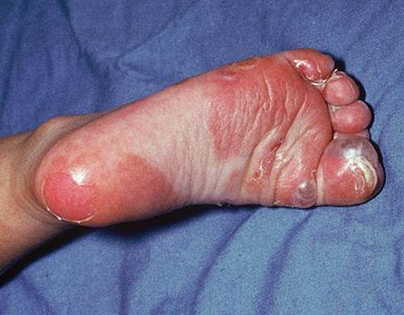Epidermolysis bullosa is a rare genetic condition in which the skin becomes so fragile that it can be instantly injured at the slightest touch.
Children born with this diagnosis are often referred to as "butterfly babies" because their skin appears as fragile as a butterfly's wing.
There is currently no cure for this disease, but the doctor needs to know how to improve the patient's condition. On estet-portal.com read about methods of preventing complications of the disease.
Epidermolysis bullosa: main types of the disease
There are several main types of epidermolysis bullosa:
• Bullosa Simplex epidermolysis: the most common type and is first seen in newborns. Mainly affects palms and soles;
• Borderline epidermolysis bullosa: a more severe form that is accompanied by active formation of granulation tissue;
• bullous dystrophic epidermolysis. Characterized by the absence of collagen or a violation of its function;
• Kindler's syndrome. A severe form in which blisters are located at different levels of the skin.
Almost all types of epidermolysis bullosa are due to a genetic predisposition.
Epidermolysis bullosa is diagnosed by a skin biopsy followed by examination of the material using transmission electron microscopy or indirect immunofluorescence.
You may also be interested in: How dangerous is Dühring's dermatitis herpetiformis
Clinical presentation of epidermolysis bullosa
Epidermolysis bullosa usually first appears in infants. Painful blisters appear on the skin, which quickly open up, forming erosions. These elements can be located on any part of the skin, as well as on the mucous membrane of the mouth, stomach or bladder.
Blisters can form locally on the hands or feet, or affect the entire skin, which can be fatal. With a simple and borderline form of epidermolysis bullosa, the blisters heal without scarring.
Read the latest articles in Telegram!
Treatment and prevention of recurrence in epidermolysis bullosa
Unfortunately, there is no universal cure for epidermolysis bullosa. The task of the doctor in this case is to teach the patient how to properly care for their skin, which will not only help to avoid complications, but also reduce the severity of the pain syndrome.

To prevent blistering in epidermolysis bullosa, the patient needs to follow simple instructions:
• minimize skin friction: lotions and creams should be used to keep the skin as hydrated as possible, as well as diapers used for children with this disease, as well as clothing, should be as loose as possible;
• Adhesive or semi-adhesive dressings, adhesive plasters or adhesive tape should not be applied to the surface of the skin. Instead, wounds should be covered with an appropriate non-adhesive dressing and then additionally wrapped with gauze;
• keep the skin cool: Nothing hot should be applied to the skin of a patient with epidermolysis bullosa. In particular, the bath water should not be warmer than body temperature. Patients should avoid prolonged exposure to ambient temperature and humidity;
• remove fluid from blisters to prevent their enlargement;
• prevent infection of wounds by treating them.
It is very important that all patients with epidermolysis bullosa have at least an annual examination of all areas of the skin, as they have an increased risk of skin cancer.
Scientists are actively searching for ways to treat epidermolysis bullosa, however, while there are no drugs for its therapy, the task of the doctor – alleviate suffering and prevent deterioration of the patient's condition.
Read also: Bullous pemphigoid: aka Lever's pemphigoid and non-acantholytic pemphigus







Add a comment